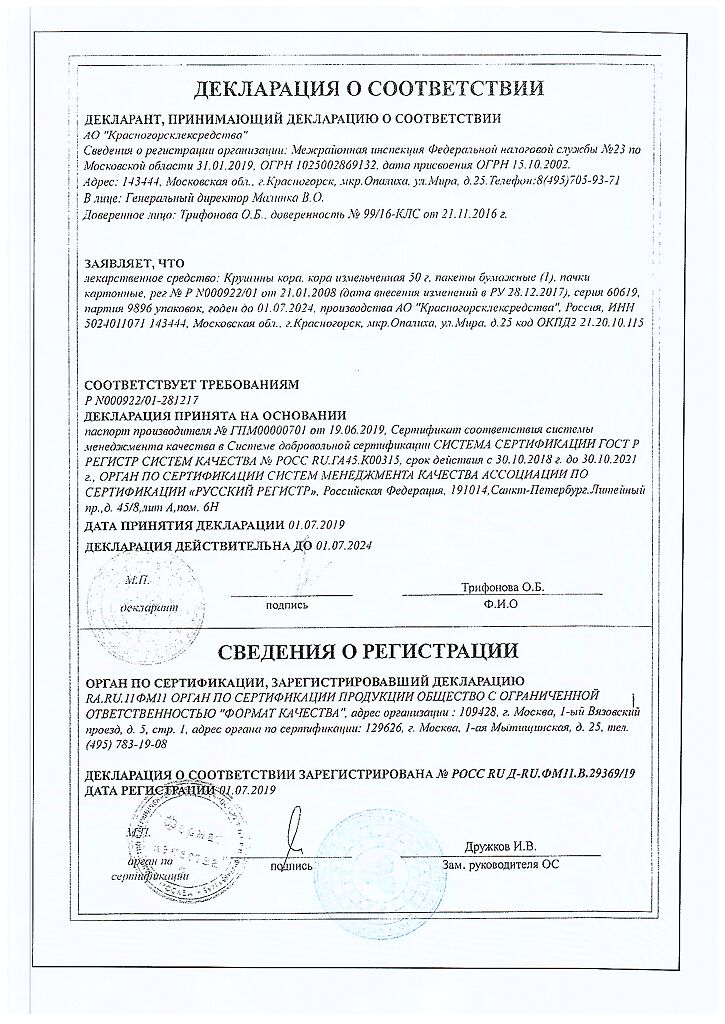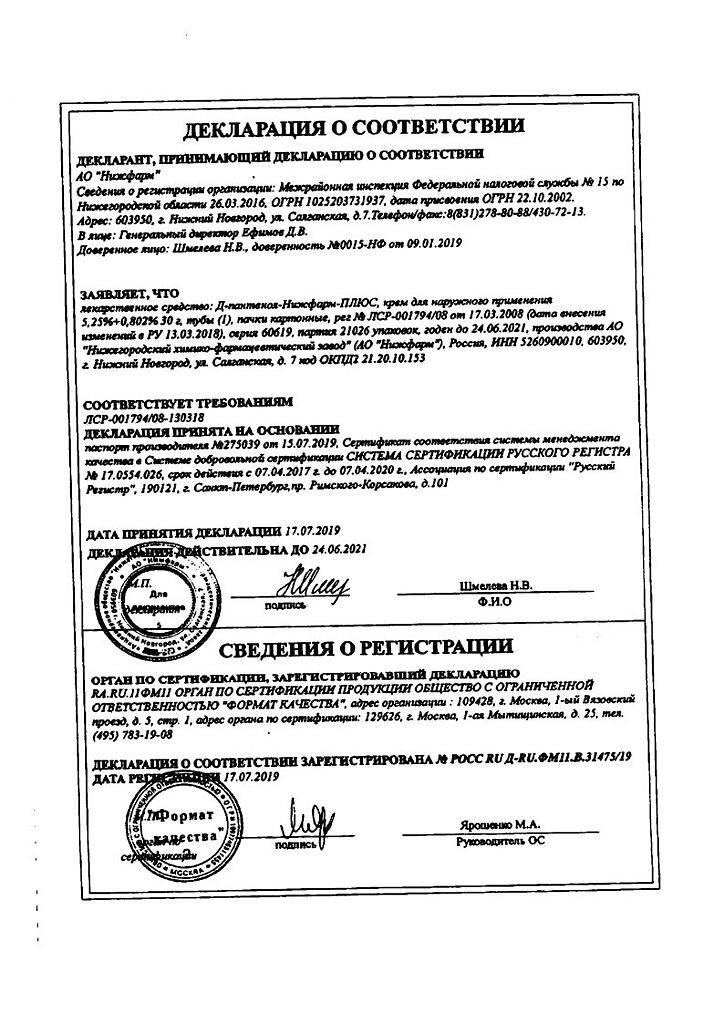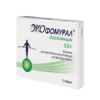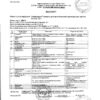No products in the cart.
Description
Pharmacotherapeutic group
Antibiotic
ATX code
J01XX01
Pharmacodynamics:
Ecofomural® (active ingredient: phosphomycin) is a broad-spectrum antibiotic derived from phosphonic acid.
Ecofomural® being a structural analogue of phosphoenol pyruvate inactivates the enzyme N-acetylglucosamino-3-o-enolpyruvil-transferase irreversibly blocks condensation of uridine diphosphate-N-acetylglucosamine with phosphoenol pyruvate inhibits the synthesis of UDF-N-acetylmuramic acid as a result of which the initial stage of bacterial cell wall peptidoglycan formation is suppressed and, as a consequence, microbial cell death occurs (bactericidal action). Inactivation of N-acetyl-glucosamine-3-o-enolpyruvil-transferase enzyme reduces the possibility of cross-resistance to antibiotics with a similar mechanism of action and creates conditions for synergism (in vitro experiments synergistic effect with amoxicillin cephalexin pepemidic acid was revealed).
Invitro to fosfomycin are sensitive Gram-positive (Staphylococcus saprophyticus Enterococcus faecalis) and Gram-negative (Escherichia coli Klebsiella pneumonia Citrobacler spp. Enterobacter spp. Proteus mirabilis) microorganisms.
Fosfomycin reduces adhesion of a number of bacteria on the epithelium of the urinary tract.
Pharmacokinetics:
Intake:
Phosphomycin is rapidly absorbed from the gastrointestinal tract when taken orally. In the body it dissociates into phosphomycin and trometamol. The latter has no antibacterial properties. Bioavailability of a single oral dose of 30 g is 34 to 65%. Maximum plasma concentration (Cmax) is observed 2-25 hours (Tmax) after oral administration and is 22-32 mg/l (Cmax). The plasma elimination half-life is 4 hours.
Distribution:
Phosphomycin does not bind to plasma proteins and is not metabolized in the body and accumulates in the urine. When a single dose of 30 g is taken orally, a high concentration of the antibiotic (1,053 to 4,415 mg/L) pa 99% bactericidal for most common pathogens of urinary tract infections is achieved in the urine. The minimum inhibitory concentration of phosphomycin for these pathogens is 128 mg/L and is maintained in the urine for 24-48 hours, which suggests a one-day course of treatment with a single administration of the drug.
90% of phosphomycin is excreted unchanged by the kidneys with high concentrations in the urine. About 10% of the administered dose of the drug is excreted unchanged in the intestine. In patients with moderately reduced renal function (creatinine clearance <80 ml/min) including age-related physiological reduction in renal function (elderly people) the half-life of phosphomycin is prolonged but the concentration in urine remains at therapeutic level.
Indications
Indications
Acute uncomplicated infections of the lower urinary tract (acute cystitis) in women aged 18 years and older, caused by pathogenic microorganisms sensitive to fosfomycin: Escherichia coli, Enterococcus faecalis. Fosfomycin is not indicated for the treatment of pyelonephritis or perinephric abscess.
Pharmacological effect
Pharmacological effect
Pharmacotherapeutic group
Antibiotic
ATX code
J01XX01
Pharmacodynamics:
Ecofomural® (active substance: fosfomycin) is a broad-spectrum antibiotic derived from phosphonic acid.
Ecomural®, being a structural analogue of phosphoenol pyruvate, inactivates the enzyme N-acetyl-glucosamino-3-o-enolpyruvil transferase, irreversibly blocks the condensation of uridine diphosphate-N-acetyl-glucosamine with phosphoenol pyruvate, inhibits the synthesis of UDP-N-acetylmuramic acid acids, as a result of which the initial stage of peptidoglycan formation in the bacterial cell wall is suppressed and, as a result, the death of the microbial cell occurs (bactericidal effect). Inactivation of the enzyme N-acetyl-glucosamino-3-o-enolpyruvil transferase reduces the likelihood of cross-resistance to antibiotics with a similar mechanism of action and creates conditions for synergy (in vitro experiments revealed a synergistic effect with amoxicillin, cephalexin, and pipemidic acid).
In vitro, gram-positive (Staphylococcus saprophyticus Enterococcus faecalis) and gram-negative (Escherichia coli Klebsiella pneumonia Citrobacler spp. Enterobacter spp. Proteus mirabilis) microorganisms are sensitive to fosfomycin.
Invitro fosfomycin reduces the adhesion of a number of bacteria to the epithelium of the urinary tract.
Pharmacokinetics:
Suction:
Fosfomycin is rapidly absorbed from the gastrointestinal tract when taken orally. In the body it dissociates into fosfomycin and trometamol. The latter does not have antibacterial properties. The bioavailability of a single oral dose of 30 g ranges from 34 to 65%. The maximum plasma concentration (Cmax) is observed 2-25 hours (Tmax) after oral administration and is 22-32 mg/l (Cmax). The half-life from blood plasma is 4 hours.
Distribution:
Fosfomycin does not bind to plasma proteins, is not metabolized in the body, and accumulates in the urine. With oral administration of a single dose of 30 g in urine, a high concentration of the antibiotic is achieved (from 1053 to 4415 mg/l) and is 99% bactericidal for most common pathogens of urinary tract infections. The minimum inhibitory concentration of fosfomycin for these pathogens is 128 mg/l and is maintained in the urine for 24-48 hours, which suggests a one-day course of treatment with a single dose of the drug.
Removal:
90% of fosfomycin is excreted unchanged by the kidneys, creating high concentrations in the urine. About 10% of the taken dose of the drug is excreted unchanged by the intestines. In patients with moderately reduced renal function (creatinine clearance <80 ml/min), including age-related physiological decline in renal function (elderly), the half-life of fosfomycin is prolonged but the concentration in urine remains at a therapeutic level.
Special instructions
Special instructions
Taking Ecofomural® with food slows down its absorption, and therefore it is recommended to take the drug 2-3 hours before or after meals.
During or after treatment with fosfomycin, diarrhea may occur; in this case, the diagnosis of pseudomembranous colitis, which requires appropriate treatment, should be excluded. The use of drugs that suppress intestinal motility is contraindicated.
Patients with diabetes should take into account that the drug contains maltitol. Insulin is required for the metabolism of maltitol, but due to its slow and poor absorption from the gastrointestinal tract, maltitol has little effect on plasma glucose concentrations, so dose adjustment of hypoglycemic drugs is not required.
Due to the maltitol content, Ecofomural® is not recommended for use in patients with hereditary fructose intolerance.
Active ingredient
Active ingredient
Fosfomycin
Composition
Composition
Composition per package:
active substance: fosfomycin trometamol (in terms of 100% substance) – 5.629 g; in terms of fosfomycin – 3.0 g;
excipients: lactulose – 1.500 g, sodium saccharinate – 0.016 g, strawberry flavoring – 0.070 g, maltitol – up to a weight of 8.0 g.
Pregnancy
Pregnancy
During pregnancy, it is used only if the expected benefit to the mother outweighs the potential risk to the fetus. When prescribing the drug during lactation, it is necessary to stop breastfeeding for the duration of therapy.
Contraindications
Contraindications
Hypersensitivity to fosfomycin.
Side Effects
Side Effects
In three studies conducted in the United States, 1233 patients received fosfomycin therapy. The most common adverse reactions occurring in >1% of patients, regardless of association with drug use, were diarrhea (10.4%), headache (10.3%), vaginitis (7.6%), nausea (5.2%), rhinitis (4.5%), back pain (3.0%), dysmenorrhea (2.6%), pharyngitis (2.5%), dizziness (2.3%), abdominal pain (2.2%), pain (2.2%), dyspepsia (1.8%), asthenia (1.7%) and rash (1.4%).
In addition, the following adverse reactions were observed with a frequency of less than 1%: stool disorders, anorexia, constipation, dry mouth, dysuria, hearing loss, fever, flatulence, influenza-like syndrome, hematuria, infections, insomnia, lymphadenopathy, menstrual irregularities, migraine, myalgia, nervousness, paresthesia, itching, skin diseases (disorders). skin) and vomiting.
In the US study population, statistically significant laboratory changes reported without regard to drug association included increased eosinophils, increased or decreased white blood cell counts, increased bilirubin, ALT and AST, ALP, decreased hematocrit, decreased Hb, and increased and decreased platelet counts. Changes were usually transient, clinically insignificant and occurred in less than 1% of patients.
In the same population, studies were conducted of adverse reactions that were considered to be associated with fosfomycin and were observed in more than 1% of patients receiving fosfomycin. These included diarrhea (9%), vaginitis (5.5%), nausea (4.1%), headache (3.9%), dizziness (1.3%), asthenia (1.1%) and dyspepsia (1.1%). The most commonly observed reaction, diarrhea, was considered mild and transient (resolved without any intervention).
One case of unilateral optic neuritis has been reported and was considered likely to be associated with fosfomycin use.
During post-marketing experience with fosfomycin, reports of vulvovaginitis, tachycardia, hearing loss, urticaria and anaphylactic reactions, including anaphylactic shock and hypersensitivity, have been reported. Cases of angioedema, aplastic anemia, asthma (exacerbation), cholestatic jaundice, general loss of taste, hepatic necrosis, metallic taste in the mouth and vestibular disorders have also been reported. One case of toxic megacolon has been reported and was found to be unrelated to fosfomycin.
Interaction
Interaction
Metoclopramide. With the simultaneous use of fosfomycin and metoclopramide, which increases gastrointestinal motility, the concentration of fosfomycin in the blood serum and its excretion in the urine decreases. Other drugs that increase gastrointestinal motility may have a similar effect.
Probenecid. Probenecid should not be co-administered with fosfomycin as it has been shown to significantly reduce the renal clearance and elimination of fosfomycin.
Probenecid, when administered to healthy volunteers receiving an infusion of fosfomycin disodium, significantly reduced renal clearance, probably due to inhibition of tubular secretion, resulting in decreased drug concentrations in urine.
The effect of metoclopramide and probenecid on urinary fosfomycin levels following co-administration with fosfomycin in women with acute urinary tract infection has not been evaluated therapeutically. Based on data obtained from healthy volunteers, urinary concentrations of fosfomycin cannot exceed the bactericidal concentration for a sufficiently long period of time to result in microbiological cure. None of these drugs should be co-administered with fosfomycin.
Cimetidine. Cimetidine does not affect the pharmacokinetics or urinary concentrations of fosfomycin when used together.
Eating. Eating delays the absorption of fosfomycin, which leads to a decrease in Cmax in blood plasma and concentration in urine. Therefore, it is recommended to take fosfomycin tromethamine on an empty stomach or at least 2–3 hours after a meal.
Overdose
Overdose
Data on oral overdose of fosfomycin are limited.
Symptoms: in cases of overdose with parenteral use, hypotension, drowsiness, fluid and electrolyte imbalances, thrombocytopenia and hypoprothrombinemia have been reported.
Treatment: in case of overdose, symptomatic and supportive therapy should be carried out. Urinary excretion of fosfomycin should be stimulated by adequate fluid intake.
Storage conditions
Storage conditions
In a place protected from moisture and light at a temperature not exceeding 25 ° C. Keep out of the reach of children.
Shelf life
Shelf life
2 years.
Do not use after expiration date.
Manufacturer
Manufacturer
ABVA RUS, Russia
Additional information
| Shelf life | 2 years. Do not use after the expiration date. |
|---|---|
| Conditions of storage | Store in a place protected from moisture and light at a temperature not exceeding 25 °С. Keep out of reach of children. |
| Manufacturer | Avva Rus, Russia |
| Medication form | granules for preparation of oral solution |
| Brand | Avva Rus |
Related products
Buy Ecofomural, 3 g with delivery to USA, UK, Europe and over 120 other countries.






















